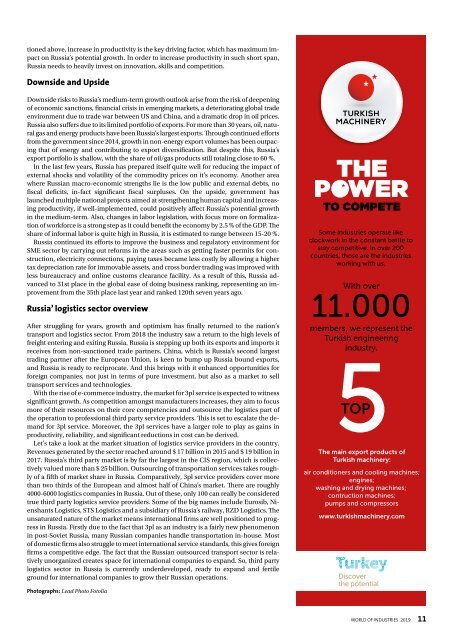WORLD OF INDUSTRIES 04/2019 (EN)
WORLD OF INDUSTRIES 04/2019 (EN)
WORLD OF INDUSTRIES 04/2019 (EN)
Create successful ePaper yourself
Turn your PDF publications into a flip-book with our unique Google optimized e-Paper software.
tioned above, increase in productivity is the key driving factor, which has maximum impact<br />
on Russia’s potential growth. In order to increase productivity in such short span,<br />
Russia needs to heavily invest on innovation, skills and competition.<br />
Downside and Upside<br />
Downside risks to Russia’s medium-term growth outlook arise from the risk of deepening<br />
of economic sanctions, financial crisis in emerging markets, a deteriorating global trade<br />
environment due to trade war between US and China, and a dramatic drop in oil prices.<br />
Russia also suffers due to its limited portfolio of exports. For more than 30 years, oil, natural<br />
gas and energy products have been Russia’s largest exports. Through continued efforts<br />
from the government since 2014, growth in non-energy export volumes has been outpacing<br />
that of energy and contributing to export diversification. But despite this, Russia’s<br />
export portfolio is shallow, with the share of oil/gas products still totaling close to 60 %.<br />
In the last few years, Russia has prepared itself quite well for reducing the impact of<br />
external shocks and volatility of the commodity prices on it’s economy. Another area<br />
where Russian macro-economic strengths lie is the low public and external debts, no<br />
fiscal deficits, in-fact significant fiscal surpluses. On the upside, government has<br />
launched multiple national projects aimed at strengthening human capital and increasing<br />
productivity, if well-implemented, could positively affect Russia’s potential growth<br />
in the medium-term. Also, changes in labor legislation, with focus more on formalization<br />
of workforce is a strong step as it could benefit the economy by 2.5 % of the GDP. The<br />
share of informal labor is quite high in Russia, it is estimated to range between 15-20 %.<br />
Russia continued its efforts to improve the business and regulatory environment for<br />
SME sector by carrying out reforms in the areas such as getting faster permits for construction,<br />
electricity connections, paying taxes became less costly by allowing a higher<br />
tax depreciation rate for immovable assets, and cross border trading was improved with<br />
less bureaucracy and online customs clearance facility. As a result of this, Russia advanced<br />
to 31st place in the global ease of doing business ranking, representing an improvement<br />
from the 35th place last year and ranked 120th seven years ago.<br />
Russia’ logistics sector overview<br />
After struggling for years, growth and optimism has finally returned to the nation’s<br />
transport and logistics sector. From 2018 the industry saw a return to the high levels of<br />
freight entering and exiting Russia. Russia is stepping up both its exports and imports it<br />
receives from non-sanctioned trade partners. China, which is Russia’s second largest<br />
trading partner after the European Union, is keen to bump up Russia bound exports,<br />
and Russia is ready to reciprocate. And this brings with it enhanced opportunities for<br />
foreign companies, not just in terms of pure investment, but also as a market to sell<br />
transport services and technologies.<br />
With the rise of e-commerce industry, the market for 3pl service is expected to witness<br />
significant growth. As competition amongst manufacturers increases, they aim to focus<br />
more of their resources on their core competencies and outsource the logistics part of<br />
the operation to professional third party service providers. This is set to escalate the demand<br />
for 3pl service. Moreover, the 3pl services have a larger role to play as gains in<br />
productivity, reliability, and significant reductions in cost can be derived.<br />
Let’s take a look at the market situation of logistics service providers in the country.<br />
Revenues generated by the sector reached around $ 17 billion in 2015 and $ 19 billion in<br />
2017. Russia’s third party market is by far the largest in the CIS region, which is collectively<br />
valued more than $ 25 billion. Outsourcing of transportation services takes roughly<br />
of a fifth of market share in Russia. Comparatively, 3pl service providers cover more<br />
than two thirds of the European and almost half of China’s market. There are roughly<br />
4000-6000 logistics companies in Russia. Out of these, only 100 can really be considered<br />
true third party logistics service providers. Some of the big names include Eurosib, Nienshants<br />
Logistics, STS Logistics and a subsidiary of Russia’s railway, RZD Logistics. The<br />
unsaturated nature of the market means international firms are well positioned to progress<br />
in Russia. Firstly due to the fact that 3pl as an industry is a fairly new phenomenon<br />
in post-Soviet Russia, many Russian companies handle transportation in-house. Most<br />
of domestic firms also struggle to meet international service standards, this gives foreign<br />
firms a competitive edge. The fact that the Russian outsourced transport sector is relatively<br />
unorganized creates space for international companies to expand. So, third party<br />
logistics sector in Russia is currently underdeveloped, ready to expand and fertile<br />
ground for international companies to grow their Russian operations.<br />
Photographs: Lead Photo Fotolia<br />
<strong>WORLD</strong> <strong>OF</strong> <strong>INDUSTRIES</strong> <strong>2019</strong> 11<br />
Turkish Machinery.indd 1 14.08.<strong>2019</strong> 11:01:35
















